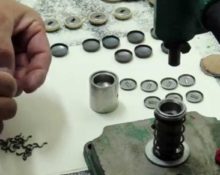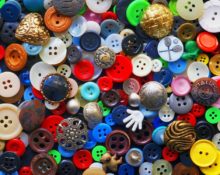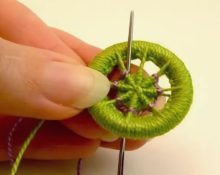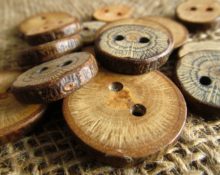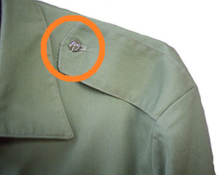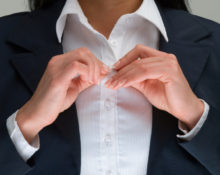The button has become such a fixture in everyday life that it is now unlikely to imagine clothing without it. The shape, size and design of modern fasteners can be anything - from the usual ordinary to the exclusive! What are they made of?
What materials are buttons made from?
 A button is a simple device: a disk with holes or a stem. The variety of options is achieved by the shape - from traditionally round to triangular and the use of various materials, cheap and expensive. And using different materials!
A button is a simple device: a disk with holes or a stem. The variety of options is achieved by the shape - from traditionally round to triangular and the use of various materials, cheap and expensive. And using different materials!
Made of metal
With this type of fittings, various options for uniforms are developed, giving it both severity and formality. It is also used in civilian clothes. The material goes to:
- copper;
- steel;
- aluminum;
- brass.
Sometimes precious metals are used - for clothes from expensive collections. To give products a more status-like appearance, gold and brass coatings are used. “Silver” coatings are applied with nickel.
Important! When choosing coated metal buttons, keep in mind that their accessories will come into contact with the fabric! Black nickel will hopelessly stain a shirt or blouse.
From mother of pearl
Mother of pearl clasps have been used since the 18th century. Now they decorate the most expensive shirts and blouses. And for good reason: made from elasmobranch shells, these products shimmer with rainbow tints in the slightest light, giving clothes a luxurious look!
Important! The consumer goods industry has learned to make counterfeits of anything, sometimes of good quality! You can distinguish pseudo-mother-of-pearl by touching the button with your lips - mother-of-pearl is always cold. The warmth of the material is a sign of plastic.
Made of plastic
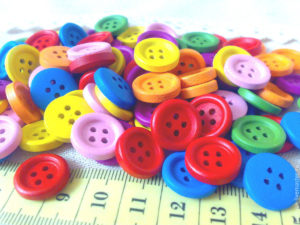 Now this is the most popular accessory option, used in both budget and expensive clothing options. They show off on shirts and jackets, coats and trousers. They may have fastener functions, or they may be decorative.
Now this is the most popular accessory option, used in both budget and expensive clothing options. They show off on shirts and jackets, coats and trousers. They may have fastener functions, or they may be decorative.
The undivided dominance of plastic began in the 30s of the last century, when the enterprising Elsa Schiaparelli opened her production in Paris, with the support of the chemist Jean Clément. The union of science and creativity made it possible to create a huge number of hitherto unseen buttons - in the form of fruits and animals, flowers and household items!
From shells
Not to be confused with mother-of-pearl! In this case we are talking about buttons made from cheaper Troka shellfish. Differences:
- thinner;
- almost no flicker;
- the reverse side is covered with brown spots.
Important! Products made from trok are as cold to the touch as mother-of-pearl!
Made of wood
Simple and at the same time stylish, they will fit perfectly into boho, country or ethnic clothing.
Their skin
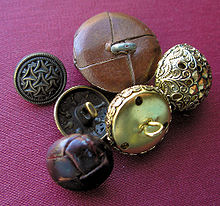 This refers to a model of fittings when a plastic or wooden product on a leg is covered with leather.They are produced on an industrial scale and by hand, as a sign of exclusivity or simply handmade. They are also used for interior decoration - furniture, wall panels.
This refers to a model of fittings when a plastic or wooden product on a leg is covered with leather.They are produced on an industrial scale and by hand, as a sign of exclusivity or simply handmade. They are also used for interior decoration - furniture, wall panels.
From bone
One of the oldest types of fittings. Made from ornamental bone that has undergone a bleaching procedure.
Important! When using an item with bone buttons, handle it with care: treated bone breaks easily!
Made from ebonite
Resembling plastic, ebonite turned out to be a suitable material for household items and jewelry. Buttons made from it look noble and are durable.
Important! Be careful with bleaches - ebonite is destroyed upon contact with chlorine-containing substances. And in bright light it can turn green, oxidizing.
Production technology
The manufacturing process is quite simple, and the nuances depend on the material from which the button will be made. The process common to all options is divided into stages:
 preparation of raw materials;
preparation of raw materials;- giving shape;
- drilling holes or making a structure from a leg:
- design processing of the product.
Plastic fasteners are made from polyester resins mixed with fixatives and dyes. The raw material is driven through a drum, resulting in something like a mat of the required thickness. The “rug” is sent to a stamp, where a rondel is cut out of it - blanks for future buttons. Sometimes a rondel is made by pouring a plastic mixture into molds under pressure.
The hardened rondel is machined to the desired shape, after which two or four holes are drilled. Or, a leg is made, which is much more expensive: a significant amount of material goes into processing.
Then the buttons are polished in tumbling drums - rotating with water and cubes of ceramics and pieces of pumice loaded there.For branded items, fasteners are decorated using laser engraving or branded prints.
A special case is exclusive fittings: they are poured into special forms, sometimes with beads, rhinestones, and decorative elements.
Advice! Looking for a place in the handmade world? Making buttons can become not only a way of spending leisure time, but also a profitable business!
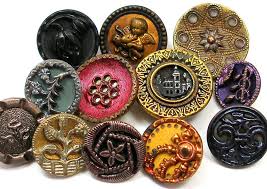 A mother-of-pearl button is more difficult to make - the material for it must be fresh and at least 12 cm in length. Blanks are cut out of the shell using special cutters, and the dark layers are removed by grinding in a special machine that “scrapes” the rondel to the required thickness. The technology of applying the pattern is also specific - to obtain it, part of the surface is cut off. Then the holes are drilled.
A mother-of-pearl button is more difficult to make - the material for it must be fresh and at least 12 cm in length. Blanks are cut out of the shell using special cutters, and the dark layers are removed by grinding in a special machine that “scrapes” the rondel to the required thickness. The technology of applying the pattern is also specific - to obtain it, part of the surface is cut off. Then the holes are drilled.
Metal fasteners take shape through the process of casting or stamping, the desired characters are engraved, and the image is applied with enamels - hot or cold. Sometimes - photo-etching.
Advice! Is your metal button tarnished? Brass can be easily cleaned with vinegar, and copper with soapy water: after cleaning the clasp, rub it until shiny with felt or a soft cloth. Silver will return to its previous appearance after cleaning with toothpaste.


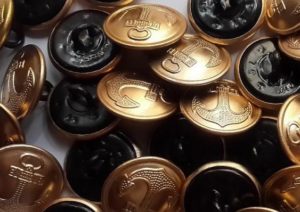 preparation of raw materials;
preparation of raw materials; 0
0